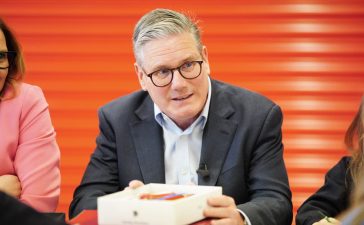BUY: Bioventix (BVXP)
The shares are down 13 per cent across the year, but this is potentially out of step with the company’s earnings potential, writes Jennifer Johnson.
Monoclonal antibodies, or clones of a single antibody, are a key component of many clinical diagnostic tests. Surrey-based Bioventix is a supplier of sheep monoclonal antibodies (SMAs) for use in a variety of human blood tests around the world. It might sound like a niche line of work, but the company saw progress across the year to the end of June in a way that many other biotechs did not.
The company reports that its most significant revenue stream continues to come from a vitamin D antibody known as vitD3.5H10 – which is used to test for vitamin D deficiency. Sales of the substance were up 7 per cent to almost £6mn last year.
In addition to the physical antibodies themselves, the sale of diagnostic solutions based on Bioventix products means the company also receives royalty payments. These account for some 70 per cent of the company’s annual revenue, according to its full-year results.
After the initiation of a new project, either with a partner firm or on its own, it takes around a year for Bioventix scientists to create a panel of purified antibodies for evaluation by customers. From there, it can take years for new diagnostic tests made with the antibodies to receive regulatory approval. This means that revenue for the current accounting period is actually derived from SMAs created many years ago.
Bioventix estimates that current research work in its labs is likely to generate sales between 2028 and 2038. In the meantime, the company forecasts continued growth in revenue from its troponin antibody, which can be used to diagnose heart attacks. Bioventix has a contract with Siemens to supply the substance for use in its diagnostic tests until 2032.
Strange as sheep antibodies might seem, it’s clear they’re in demand.
SELL: Asos (ASC)
Debt is flashing red at the fast fashion retailer after a difficult 12 months, writes Jemma Slingo.
The fast-fashion company kicked off its financial year with far too much stock, carrying forward £1.1bn of clothes, shoes and cosmetics. This followed four years of dubious inventory management, during which stock levels doubled, discounting surged and margins took a hit.
Recent attempts to shift the excess stock coincided with weak consumer sentiment and high inflation, however, and the result has not been pretty.
After delaying its results by a few days, Asos has now reported a 10 per cent drop in sales, a free cash outflow of £213mn, and an adjusted operating loss of £29mn, compared with a £44mn profit last year. Its statutory loss was far bigger at £249mn, and included £133mn of stock write-offs, as well as restructuring and property costs. (The group has shrunk its head office and its warehouse footprint.)
So what happens next? There are some positive signs, with profit per order up by a third and average basket value up by 5 per cent. This is partly because Asos is shedding “lower quality” customers acquired during the pandemic. New chief executive José Antonio Ramos Calamonte is also pushing for cost savings and wants to “refresh the culture”.
However, he thinks sales will fall again next year by between 5 per cent and 15 per cent. This is a significantly worse picture that many analysts had anticipated. Meanwhile, although the group expects to return to growth in the final quarter of full-year 2024, there is little visibility of how demand will actually fare, and the “final cleansing” of stock is also due to keep dragging on profits.
Even more worrying is Asos’s debt position. Management has refinanced the balance sheet and believes there is “more stability” as profit-based covenants have been removed. Asos only has a minimum liquidity covenant of £90mn to worry about now.
However, the new debt facilities, which came into effect in May, bear an interest rate above the sterling overnight index average (Sonia), which itself was 5.2 per cent at the period end. Meanwhile, Asos’s level of borrowing has surged: net debt more than doubled year on year to £320mn.
Given that there are already signs of spiralling finance costs — they doubled to £46mn last year — this sets off serious alarm bells. Last year’s free cash outflow of £213mn looked bad enough, but things could easily get worse.
HOLD: Ultimate Products (ULTP)
Retail sales were hit by inventory headwinds, but the company still delivered record results, writes Christopher Akers.
Ultimate Products — which changed its name in October from UP Global Sourcing Holdings — has maintained its defensive position on prices in an attempt to incentivise consumer demand for its heritage brands. The evidence suggests its strategy of “resetting” prices by introducing hundreds of new products each year is working out. The homeware company posted record annual revenues, along with its highest adjusted cash profit of over £20mn, as online sales shot up by 64 per cent.
On the other hand, excess inventory stemming from the pandemic hit sales to supermarkets and retailers. This was seen in the mixed brand performance. While sales at key brand Salter rose by 39 per cent, laundry and floorcare brand Kleeneze’s sales were up by a fifth, and German kitchen electrical brand Petra brought in more than £3mn of revenue after being relaunched, the top line at the company’s other brands went backwards.
Gross margin was aided by lower shipping rates and was up by 80 basis points from last year to 25.7 per cent. Investment in robotics is helping operating margins, with automation saving more than 1,000 employee hours each week.
Elsewhere, leverage fell from 1.3 times to 0.7 times. Cash generated from operating activities rose significantly from £6.8mn to £24.4mn year-on-year, with operating cash conversion improving to 121 per cent.
The shares trade at an undemanding 7.8-times broker Canaccord Genuity’s forward earnings forecast. Ultimate Product’s managing director Andrew Gossage told Investors’ Chronicle that expansion in Western Europe is something the company is aiming for in the medium- to long-term and we think this is something to watch.









